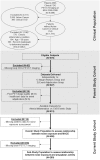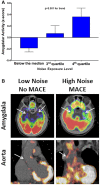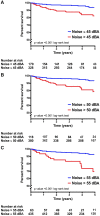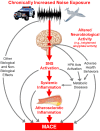A neurobiological mechanism linking transportation noise to cardiovascular disease in humans
- PMID: 31769799
- PMCID: PMC7006229
- DOI: 10.1093/eurheartj/ehz820
A neurobiological mechanism linking transportation noise to cardiovascular disease in humans
Abstract
Aims: Chronic noise exposure associates with increased cardiovascular disease (CVD) risk; however, the role of confounders and the underlying mechanism remain incompletely defined. The amygdala, a limbic centre involved in stress perception, participates in the response to noise. Higher amygdalar metabolic activity (AmygA) associates with increased CVD risk through a mechanism involving heightened arterial inflammation (ArtI). Accordingly, in this retrospective study, we tested whether greater noise exposure associates with higher: (i) AmygA, (ii) ArtI, and (iii) risk for major adverse cardiovascular disease events (MACE).
Methods and results: Adults (N = 498) without CVD or active cancer underwent clinical 18F-fluorodeoxyglucose positron emission tomography/computed tomography imaging. Amygdalar metabolic activity and ArtI were measured, and MACE within 5 years was adjudicated. Average 24-h transportation noise and potential confounders were estimated at each individual's home address. Over a median 4.06 years, 40 individuals experienced MACE. Higher noise exposure (per 5 dBA increase) predicted MACE [hazard ratio (95% confidence interval, CI) 1.341 (1.147-1.567), P < 0.001] and remained robust to multivariable adjustments. Higher noise exposure associated with increased AmygA [standardized β (95% CI) 0.112 (0.051-0.174), P < 0.001] and ArtI [0.045 (0.001-0.090), P = 0.047]. Mediation analysis suggested that higher noise exposure associates with MACE via a serial mechanism involving heightened AmygA and ArtI that accounts for 12-26% of this relationship.
Conclusion: Our findings suggest that noise exposure associates with MACE via a mechanism that begins with increased stress-associated limbic (amygdalar) activity and includes heightened arterial inflammation. This potential neurobiological mechanism linking noise to CVD merits further evaluation in a prospective population.
Keywords: 18F-FDG-PET/CT; Amygdalar activity; Arterial inflammation; Cardiovascular disease; Chronic noise exposure.
Published on behalf of the European Society of Cardiology. All rights reserved. © The Author(s) 2019. For permissions, please email: journals.permissions@oup.com.
Figures






References
-
- Munzel T, Schmidt FP, Steven S, Herzog J, Daiber A, Sorensen M.. Environmental noise and the cardiovascular system. J Am Coll Cardiol 2018;71:688–697. - PubMed
Publication types
MeSH terms
Substances
Grants and funding
LinkOut - more resources
Full Text Sources
Medical

